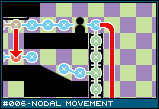|
Mechanic #006 - Nodal Movement |

Category: Tactics | Posted: 05/14/07
Through the use of a node-based movement system, more complex actions can be modeled simultaneously with movement. What other turn based system allows you to walk a few steps, wall jump up three floors, then jump off in one movement phase? |
![[advwars.png]](set01/img/entry006-advwars.png)
Technically, tactics games already use a nodal approach movement. It's just that it usually extends in a flat radius around the character (as seen above), such that all nodes are uniform and each has exactly the same number of possible inputs and outputs. Sometimes, the nodes do have special properties, like a movement cost (mountains, roads) or a required ability (flying, jumping) to move between the nodes. Even so, there is rarely the complexity of treating an action like jumping in the same way one treats walking between squares.
The basic premise behind this idea is that the nodes are not the same and that you can model very complex behavior by doing so. This is not strictly a solution to the sidescroller tactics concept, but unlike other tactics games, I'm not sure that the side view could be properly exploited without it. In a platform game, you've got to climb stairs, slide down poles, jump across pits, fire a grappling hook, crawl under a low overhang, wall-jump up the side of a cliff, or stumble up a ladder. All of these things can be presented in a more complex nodal movement system.
![[complex.png]](set01/img/entry006-complex.png)
Here is an example of a decently complex platforming level. I want a system where I can select, with the mouse or stylus, a point that the little guy can move to. Already, it becomes obvious that there is a problem getting around. He can't reach the ladder going up without jumping from the other ladder. In a typical tactics game, that would be considered an action and require a separate turn - making a climb to the top of the ladder at least three full turns to complete. And that's assuming that climbing ladders is considered equal to basic movement in the first place.
![[complex2.png]](set01/img/entry006-complex2.png)
Or we could do it in one turn by factoring in the state the unit must be in at any node. The color coding is just a visual illustration of this. For instance, when on a ladder (green nodes), there are certain actions one can perform than one can't do while walking (blue nodes). You can only perform a ladder jump between green nodes. Clicking on any of the nodes will cause the unit to pick the best path to arrive at that node, even factoring in the ladder jump.
![[complex3.png]](set01/img/entry006-complex3.png)
This is an example which includes drops. These are very quick ways to move very quickly, perhaps at a cost of health. This unit has a movement of six basic nodes. As you can see, that is not enough to either reach the bottom of the ladder, or reach most the second floor landing. However, being able to drop down by jumping, much more land is available. Also note that the ability to climb single tile walls, as seen in the bottom right, is also factored in.
There could exist certain situations where you might have multiple, similar actions available. For instance, climbing across the bar at the top, you could fall down in each of the four squares - but they all yield the exact same result. If you give each potential path a cost to get to a specific node, paths with the exact same cost can be ignored. You have less control over where you drop off, but ultimately, the same functional result will be available. In practice, I think the first available drop/jump should be enough for most cases.
For actions which may cause damage, like jumping down a cliff, it should have a very significant cost. That way if there is a better way to get to a specific node, it will be taken without the risk of taking damage. Only when that path is the only way there should it be taken.
Nodes at the top and bottom of ladders (or stairs) should probably be considered a unique state for node building. You should treat them as walking nodes for all intents and purposes, but that can connect up to down to ladders. This way, you could jump across a hole to a spot where a ladder is, but then still climb up it.
![[walljump.png]](set01/img/entry006-walljump.png)
Some kinds of movements may yield multiple different jumping off points. For instance, this wall-jump pattern can continue going up, or you can branch off the path lower down.
|